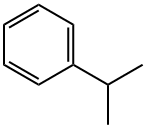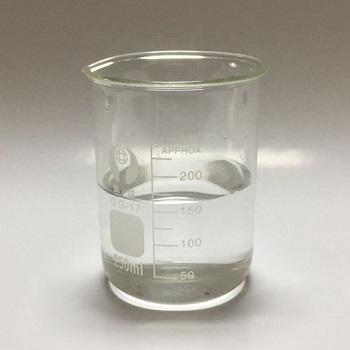General Description
A clear colorless liquid with an aromatic odor. Flash point 115°F. Less dense than water and insoluble in water. Vapors heavier than air. May be moderately toxic by inhalation, ingestion and skin absorption.
Reactivity Profile
Mixing CUMENE(98-82-8) in equal molar portions with any of the following substances in a closed container caused the temperature and pressure to increase: chlorosulfonic acid, nitric acid, oleum, NFPA 1991.
Air & Water Reactions
Flammable. Insoluble in water.
Hazard
Toxic by ingestion, inhalation, and skin
absorption; a narcotic. Moderate fire risk. Eye, skin,
and upper respiratory tract irritant, and central nervous system impairment. Possible carcinogen.
Health Hazard
Narcotic action with long-lasting effects; depressant to central nervous system.
Potential Exposure
Cumene is used primarily in the manufacture acetone and phenol which are widely used as solvents for paints, laquers, and varnishes and to make plastics. Cumene is used in gasoline blending and as a high-octane gasoline component. It is also found as a component in tobacco smoke.
Fire Hazard
HIGHLY FLAMMABLE: Will be easily ignited by heat, sparks or flames. Vapors may form explosive mixtures with air. Vapors may travel to source of ignition and flash back. Most vapors are heavier than air. They will spread along ground and collect in low or confined areas (sewers, basements, tanks). Vapor explosion hazard indoors, outdoors or in sewers. Runoff to sewer may create fire or explosion hazard. Containers may explode when heated. Many liquids are lighter than water.
First aid
If this chemical gets into the eyes, remove any contact lenses at once and irrigate immediately for at least 15 minutes, occasionally lifting upper and lower lids. Seek medical attention immediately. If this chemical contacts the skin, remove contaminated clothing and wash immediately with soap and water. Seek medical attention immediately. If this chemical has been inhaled, remove from exposure, begin rescue breathing (using universal precautions, including resuscitation mask) if breathing has stopped and CPR if heart action has stopped. Transfer promptly to a medical facility. When this chemical has been swallowed, get medical attention. Do not induce vomiting.
Shipping
UN1918 Cumene, Hazard Class: 3; Labels: 3-Flammable liquid
Incompatibilities
Vapor may form explosive mixture with air. Incompatible with oxidizers (chlorates, nitrates, peroxides, permanganates, perchlorates, chlorine, bromine, 942 Cumene fluorine, etc.); contact may cause fires or explosions. Keep away from alkaline materials, strong bases, strong acids, oxoacids, epoxides. Air contact forms cumene hydroperoxide. Attacks rubber. May accumulate static electrical charges, and may cause ignition of its vapors.
Description
Cumene is a common name for isopropylbenzene, an organic
compound. Cumene is a volatile colorless liquid at room
temperature with a characteristic sharp, penetrating, aromatic
odor. It is insoluble in water but is soluble in alcohol and many
other organic solvents. Cumene is structurally a member of the
alkyl aromatic family of hydrocarbons, which also includes
toluene (methylbenzene) and ethylbenzene.Cumene can be
found in crude oil, refined fuels, and is a part of processed highoctane
gasoline.
Cumene is manufactured by reacting benzene with
propylene at elevated temperature and pressure in the presence
of a catalyst. It is considered an environmental pollutant
because it is a natural component of petroleum and is present
in tobacco smoke. Cumene vapor can be absorbed by the respiratory tract. Sufficiently high levels of exposure to cumene
causes central nervous system (CNS) depression leading to
death, internal bleeding of numerous organs, as well as irritation
of the eyes and respiratory system, skin, and mucous
membranes. Cumene is a high production volume chemical.
Waste Disposal
Dissolve or mix the material with a combustible solvent and burn in a chemical incinerator equipped with an afterburner and scrubber. All federal, state, and local environmental regulations must be observed.
Physical properties
Colorless liquid with an aromatic odor. Experimentally determined detection and recognition odor
threshold concentrations were 40 μg/m3 (8 ppbv) and 230 μg/m3 (47 ppbv), respectively (Hellman
and Small, 1974). The taste threshold concentration in water is 60 ppb (Young et al., 1996).
Definition
ChEBI: Cumene is an alkylbenzene that is benzene carrying an isopropyl group.
Chemical Reactivity
Reactivity with Water: No reaction; Reactivity with Common Materials: No reaction; Stability During Transport: Stable; Neutralizing Agents for Acids and Caustics: Not pertinent; Polymerization: Not pertinent; Inhibitor of Polymerization: Not pertinent.
Carcinogenicity
Cumene was not a developmental toxicant
in either rats or rabbits after exposure to levels
(1200ppm and 2300ppm, respectively) associated
with maternal toxicity.9 Most genotoxic
tests with cumene have been negative.
The LD50 for penetration of rabbit skin
was 12.3 ml/kg after 14 days.4 Contact of the
liquid with the skin causes erythema and irritation.
11 Eye contamination may produce conjunctival
irritation.
It generally is agreed that cumene has no
damaging effect on the hematopoietic system,
despite its chemical similarity to benzene.5
Furthermore, cumene is not anticipated to be
a significant carcinogenic hazard because it is
metabolically similar to toluene, a substance
that showed no carcinogenic activity in 2-year
inhalation studies.
Source
As of October 1995, no MCLGs or MCLs have been proposed
although isopropylbenzene has been listed for regulation (U.S. EPA, 1996). A DWEL of 400 μg/L
was recommended (U.S. EPA, 2000).
Detected in distilled water-soluble fractions of 94 octane gasoline and Gasohol at
concentrations of 0.14 and 0.15 mg/L, respectively (Potter, 1996).
Thomas and Delfino (1991) equilibrated contaminant-free groundwater collected from
Gainesville, FL with individual fractions of three individual petroleum products at 24–25 °C for
24 h. The aqueous phase was analyzed for organic compounds via U.S. EPA approved test method
602. Average isopropylbenzene concentrations reported in water-soluble fractions of unleaded
gasoline and kerosene were 235 and 28 μg/L, respectively. When the authors analyzed the
aqueous-phase via U.S. EPA approved test method 610, average isopropylbenzene concentrations
in water-soluble fractions of unleaded gasoline and kerosene were lower, i.e., 206 and 22 μg/L,
respectively. Isopropylbenzene was detected in both water-soluble fractions of diesel fuel but were
not quantified.
Isopropylbenzene was detected in California Phase II reformulated gasoline at a concentration
of 830 mg/kg (Schauer et al., 2002).
Isopropylbenzene naturally occurs in Ceylon cinnamon, cumin, and ginger (1 ppm in rhizome)
(Duke, 1992).
Environmental Fate
ological. When isopropylbenzene was incubated with Pseudomonas putida, the substrate was converted to ortho-dihydroxy compounds in which the isopropyl part of the compound remained
intact (Gibson, 1968). Oxidation of isopropylbenzene by Pseudomonas desmolytica S44B1 and
Pseudomonas convexa S107B1 yielded 3-isopropylcatechol and a ring fission product, (+)-2-
hydroxy-7-methyl-6-oxooctanoic acid (Jigami et al., 1975).
Surface Water. Mackay and Wolkoff (1973) estimated an evaporation half-life of 14.2 min from
a surface water body that is 25 °C and 1 m deep.
Photolytic. Major products reported from the photooxidation of isopropylbenzene with nitrogen
oxides include nitric acid and benzaldehyde (Altshuller, 1983). A n-hexane solution containing
isopropylbenzene and spread as a thin film (4 mm) on cold water (10 °C) was irradiated by a
mercury medium pressure lamp. In 3 h, 22% of the applied isopropylbenzene photooxidized into
α,α-dimethylbenzyl alcohol, 2-phenylpropionaldehyde, and allylbenzene (Moza and Feicht,
1989).
A rate constant of 3.7 x 109 L/molecule·sec was reported for the reaction of isopropylbenzene
with OH radicals in the gas phase (Darnall et al., 1976). Similarly, a room temperature rate
constant of 6.6 x 10-12 cm3/molecule·sec was reported for the vapor-phase reaction of
isopropylbenzene with OH radicals (Atkinson, 1985). At 25 °C, a rate constant of 6.25 x 10-12
cm3/molecule·sec was reported for the same reaction (Ohta and Ohyama, 1985).
Chemical/Physical. Complete combustion in air yields carbon dioxide and water vapor.
Isopropylbenzene will not hydrolyze because it does not contain a hydrolyzable functional
group.
The calculated evaporation half-life of isopropylbenzene from surface water 1 m deep at 25 °C
is 5.79 h (Mackay and Leinonen, 1975).
storage
Color Code—Red: Flammability Hazard: Store ina flammable liquid storage area or approved cabinet awayfrom ignition sources and corrosive and reactive materials.May form peroxides in storage. Prior to working with thischemical you should be trained on its proper handling andstorage. Before entering confined space where this chemicalmay be present, check to make sure that an explosive concentration does not exist. Cumene must be stored to avoidcontact with oxidizers, such as permanganates, nitrites, peroxides, chlorates, and perchlorates, since violent reactionsoccur. Store in tightly closed containers in a cool well-ventilated area away from heat. Sources of ignition, such assmoking and open flames, are prohibited where Cumene isused, handled, or stored in a manner that could create apotential fire or explosion hazard. Metal containers involving the transfer of=gallons or more of this chemical shouldbe grounded and bonded. Drums must be equipped withself-closing valves, pressure vacuum bungs, and flamearresters. Use only nonsparking tools and equipment, especially when opening and closing containers of thischemical.
Toxicity evaluation
Cumene is released into the environment as a result of
production and processing from petroleum refining and the
evaporation and combustion of petroleum products. Cumene
also occurs in a variety of natural substances including
essential oils from plants and foodstuffs. When released to
soil, cumene is expected to biodegrade and may volatilize
from the soil surface. Cumene is expected to have low
mobility based on its estimated adsorption coefficient (Koc) of
820. Based on Henry’s law constant of 0.0115 atm m3 mol-1,
cumene volatilization from moist soil surfaces is expected to
be an important environmental fate and it may volatilize from
dry soil surfaces based on its vapor pressure. Cumene is
expected to strongly adsorb to soils and is not expected to
leach to groundwater.
When released into the atmosphere, a vapor pressure of
4.5 mmHg at 25°�C indicates that cumene exists solely as
a vapor in the ambient atmosphere. Cumene in the vapor
phase reacts with photochemically generated hydroxyl radicals.
The reaction of cumene in the vapor phase with ozone has an
estimated half-life of 2.5 days. Cumene may also react with
ozone radicals found in the atmosphere but not at an environmentally
important rate.

